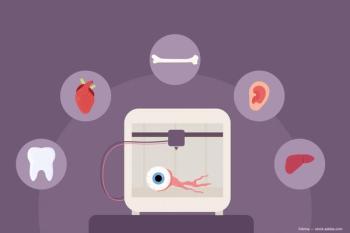
Pearls for minimally invasive strabismus surgery
Reviewed by Yi Ning Strube, MD
Minimally invasive strabismus surgery provides quicker and safer strabismus surgery, according to Yi Ning Strube.
Speaking at the virtually held 32nd Annual Jack Crawford Day, an annual pediatric ophthalmology update organized by the University of Toronto and The Hospital for Sick Children in Toronto, Strube described the advantages of minimally invasive strabismus surgery.
Strube is an associate professor and director of Pediatric Ophthalmology and Adult Strabismus at Queen's University in Kingston, Ontario, Canada.
“Minimally invasive strabismus surgery is less risky to the patient, and less painful with faster recovery compared to our traditional strabismus procedures,” Strube explained. “It is easier and faster for the surgeon and therefore less stressful.”
One of the minimally invasive strabismus surgical techniques is the central tenotomy, which can be performed with the patient fully awake as an in-office procedure.
“This procedure can correct small vertical tropias of 1-2 PD,” Strube explained. “It is a simple and quick procedure that you can do under topical anesthesia.”
Strube discussed a case of using the central tenotomy in a patient who was a retinal surgeon who had a retinal detachment which was repaired but had residual vertical diplopia and did not want to wear prism glasses.
The procedure provides a surgical alternative to prism spectacles, as it corrects very small deviations previously not amenable to surgical correction, as standard rectus muscle recessions correct much larger deviations.
A study1 published in 2009 of 15 consecutive cases by Kenneth Wright, MD, looked at the success of the central tenotomy procedure he developed to correct diplopia associated with small-angle strabismus. He reported successful treatment of hypertopias with the central tenotomy, but not for esotropias; the procedure is therefore not recommended for esotropias as these patients often have a much larger underlying esophoria.
Patients in the series were aged 35 to 86, and 11 of 15 were aged 60 and older. All 15 patients had binocular diplopia, and five of 15 were using prism glasses prior to surgery.
There are a few important steps to keep in mind when performing the central tenotomy. First topical anesthetic is applied to the eye, followed by a drop of phenylephrine 2.5% to blanch conjunctiva, allowing for improved visualization of the anterior ciliary vessels, which should be avoided, Strube explained.
Additionally, a drop of antibiotic should be applied. A 0.50 or 0.75-toothed forceps is used to grasp the central tendon of the rectus muscle through the intact conjunctiva.
“You want to move the eye and be sure you haven’t just grasped the superficial conjunctiva,” Strube said. “Make sure you are using blunt Westcott scissors and be very careful not to go too deep. You are going to hear a click when you cut through the tendon.”
The central tendon is cut between the forceps and sclera through the intact conjunctiva, noted Strube, with the central third of the tendon more relaxed, and the two muscle poles left intact, maintaining the normally broad insertion.
“The nice thing is this is repeatable, either at the time of surgery, or if the diplopia should recur,” Strube said. “The patient will tell you if they have improved or not at the time of the procedure if you are performing awake in the office. A procedure like this opens up treatment options for patients without using valuable OR time.”
Another minimally invasive strabismus procedure is the central plication, a rectus muscle tightening procedure.
“It corrects more than the tenotomy, about 6 to 8 prism D per muscle,” Strube explained. “Again, this is a procedure you can do under topical anesthesia. It is a vessel sparing procedure, and it can be reversed if needed by cutting the sutures in the first day or 2. It is really great for small angle deviations. It is hard to do a recession or resection to correct such a small amount (of deviation).”
Technically, the procedure involves a modified swan incision over the muscle, noted Strube, citing another styd by Wright and Rebecca S. Leenheer, MD.2
The retrospective study, which categorized patients by hyperdeviations, esodeviations, and exodeviations, found all patients experienced a decrease in strabismus, Strube explained. In addition, diplopia was noted in 50% of the adults preoperatively and none postoperatively.
“On average, you get about 5 to 6 prism D per muscle,” Strube noted. “You can correct about eight prism diopters if you are performing against a previously recessed antagonist muscle.”
It is important to remember that pulling on the muscle is very painful for the patient and that with minimally invasive strabismus surgery, topical anesthetic will not completely address that, said Strube. Careful tissue handling and proper technique can avoid pain in the patient, for example by using a traction suture to manipulate the eye rather than pulling on the muscle.
“The central plication is an invaluable technique that is great for post-LASIK and post-cataract patients with small angle strabismus who are keen to be out of glasses, and an additional technique for complex strabismus patients,” Strube concluded. “Both the central plication and central tenotomy procedures eliminate the need for adjustable strabismus surgery, as these simple techniques can be performed as needed as a touch up surgery to correct residual small angle deviations.”
Yi Ning Strube, MD
P: 613/544-3400
Strube has no relevant disclosures related to this content.
References
1. Kenneth W. Wright, MD. Mini-Tenotomy Procedure to Correct Diplopia Associated with Small-Angle Strabismus.Trans Am Ophthalmol Soc. 2009;107:97-103
2. Kenneth W. Wright, MD; Rebecca S. Leenheer, MD; Mini-plication to Treat Small-Angle Strabismus: A Minimally Invasive Procedure. AAPOS. August 2012: 327-330. doi: 10.1016/j/jaapos.2012.02.018.
Newsletter
Don’t miss out—get Ophthalmology Times updates on the latest clinical advancements and expert interviews, straight to your inbox.













































.png)


